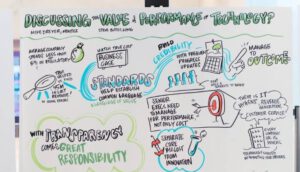How can a CIO measure
For decades, CIOs have struggled to prove that IT systems and projects generate value beyond the internal cost savings they enable or the revenue and profit growth they can help produce. Many of the top metrics that matter to business leaders don’t have anything to do with IT — and they require a more holistic view of how the company creates value, not just how it spends money.
In a rapidly changing business landscape, there is an increasing need for IT to demonstrate that the technology investments it makes have a positive impact on the business. To do so, IT must move the conversation from a focus on IT costs to a discussion of the business value that IT delivers. This transformation requires a new set of metrics, a change in mindset, and a new set of strategies.

Defining and communicating IT’s value story to business stakeholders can be challenging, but there are some best practices that can help. Using a proven methodology, CIO coaching can use the nine rules below to make their business case for IT investments.
How can a CIO measure and demonstrate the value of IT investments?
IT business value starts with a simple question: “What does the business need?” Business leaders must clearly define their desired outcomes, and CIOs should align IT initiatives to those goals. To do so, they must understand the underlying business processes that will be improved by IT solutions and what impact those improvements will have on the organization’s ability to acquire and retain customers for its products or services.
CIOs should measure the success of IT projects based on their impact on business stakeholder objectives, not just the number of hours spent by IT teams working to execute those projects. The broader goal of improving customer experience or enabling innovation will be easier to measure and quantify than a more tactical measurement like the number of emails sent out by IT staffers using a newly deployed email system.
To do their jobs well, IT leaders must ensure that everyone in the organization knows and understands the risks of IT-related events and the ways they can prevent them. This includes having a single source of truth to document possible IT risks and report on prevention tactics to help decision-makers avoid these risks.
Some technologies — such as RPA and machine learning — can have an impact on core business processes by replacing or augmenting existing functions, but they may also threaten the positions of incumbent process owners with potentially disruptive changes. IT leaders should examine new levers found at points where these emerging technologies intersect with business processes and develop a new set of metrics that can be used to track their impact on the business’s financial performance.